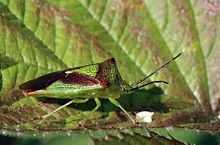Acanthosoma haemorrhoidale
| Hawthorn shield bug | |
|---|---|
 |
|
| Imago | |
 |
|
| Nymph | |
| Scientific classification | |
| Kingdom: | Animalia |
| Phylum: | Arthropoda |
| Class: | Insecta |
| Order: | Hemiptera |
| Family: | Acanthosomatidae |
| Genus: | Acanthosoma |
| Species: | A. haemorrhoidale |
| Binomial name | |
|
Acanthosoma haemorrhoidale (Linnaeus, 1758) |
|
The hawthorn shield bug (Acanthosoma haemorrhoidale) is a common European shield bug. Its chief food is haws, the fruit of the hawthorn tree, but adults can overwinter on a diet of leaves, and individuals can be found on many potential food plants, including pedunculate oak, sessile oak and whitebeam. They may grow up to 17 mm (0.67 in) long, and are camouflaged in shades of green and brown. Like many so-called "stink bugs", they may release unpleasant odours when disturbed.
The dark green scutellum band is trapezoidal in shape, and extends from the dorsal pronotum to the forewing hemelytral membrane which accounts for the final third of the main body length. The front wings lie flat without flight, with the scleratized pronotum and corium regions, coloured in a dark red pigmentation. The compound eyes are also pigmented red. There is a speckled pigmentation extending from the upper dorsal thorax to the abdominal region. The tarsi are 2-segmented and antennae 5-segmented. As a heteropteran phytophagyte of mainly green leafed trees and red berries, the species feeds through the anterior section of the rostrum, which suctions liquidised plant tissue, semi-digested by the delivery of saliva enzymes from the posterior sector of the rostrum. The rostrum beak acts as a modified proboscis formed by the interlocking of mandibular and maxillary stylet into a double-tubed elongation covered by the labium. The structure is needle shaped and penetrates beyond the cuticle and epidermis layer to access the vascular tissue of the mesophyll layer of the leaf. The rostrum pricks into berries to access fruit sugars. As a stress response, an orange secretion is secreted from gland openings in the thorax.
...
Wikipedia
